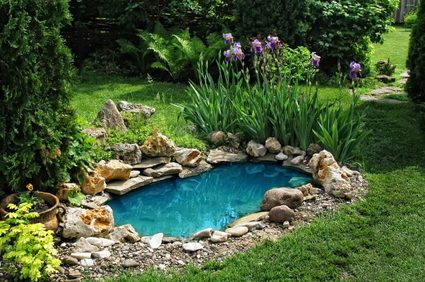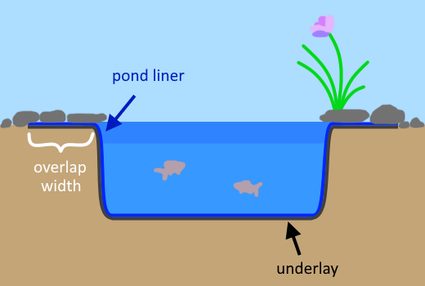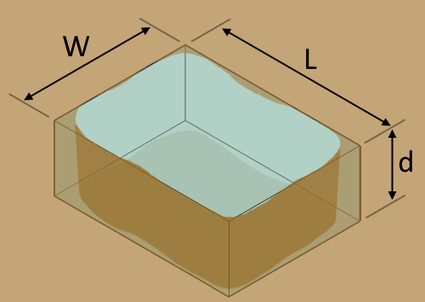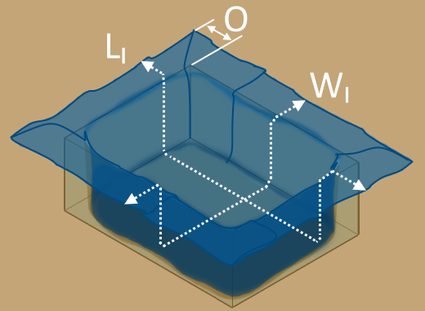Pond Calculator
If you're wondering how to calculate a fish pond volume or how to calculate how much pond liner you need, this pond calculator can help you with that.
Here is a collection of tools you can use when building a backyard fish pond or a garden pond. This calculator works as a pond size calculator that can help you find the area coverage of your pond and a pond volume calculator to help you determine the maximum volume of water your pond can hold. If you're also filling a pool with water, we have a separate pool calculator you can use for that.
This tool also works as a pond liner calculator, which can help you calculate the liner dimensions you will need for your pond. Lastly, it can estimate how much your pond will cost. Open the calculator sections Liner cost and Water cost to reveal this tool's pond cost calculator features.
In this calculator, you will also learn the basics of how to install a pond liner, may it be a plastic pond liner or a rubber pond liner. Knowing how to install a pond liner properly, together with the installation of a pond liner underlay, will determine how long your pond liner will last. Keep on reading to start learning.
Building a backyard fish pond
If you are planning to upgrade the look of your garden, adding a fish pond or a garden pond to your backyard can be one of your options. With an artificial pond in your backyard, you will have the option to plant some aquatic plants or keep fish in them.

However, when building a backyard fish pond, you need to consider some essential things to have a clean and low-maintenance pond. These things include proper sizing of the pond and the proper installation of a pond liner. If you plan to do fishkeeping, you might want to consider building a pond that is large enough to accommodate the quantity and growth of your fish.
On the other hand, installing a pond liner will keep the pond water from getting muddy as the liner prevents the water from getting in contact with the surrounding soil. As your pond ages, pond liners can develop holes that would lead to water leakages and continuous lowering of pond water level. The holes in the liner can also lead to muddy pond water due to the mixing of soil into the pond water. In that case, you should repair your pond liner immediately by patching the holes. However, if the pond liner turns out to have lots of holes, you might end up replacing the entire lining material.
With this calculator, you don't have to worry about how to calculate the pond liner size you'll need or wonder how to calculate the volume of water for your pond when refilling it. Our pond calculator will do all of it for you.
🙋 If you're an indoor type of person and would love to take care of your fish in a tank, you can check out our aquarium calculator and our aquarium glass thickness calculator if you want to learn how to build your own aquarium.
How to use our pond calculator for your pond size calculations?
Using our pond calculator is quite straightforward. Simply follow these steps:
- From the selection, choose the shape that best resembles your pond.
- Enter the maximum dimensions of your pond. These include the maximum length, width, and depth of your pond. For round ponds, enter the approximate diameter of your pond. By now, our calculator will already show you the size of your pond and how many gallons your pond can hold.
- The next step is to enter the width of the overlap of your pond liner. Doing so will display the dimensions of the pond liner you need. You can also use these dimensions for your pond liner underlay.
- In the last section of our pond calculator, you can see the total area of the pond liner you need, as well as some added features to help you with your pond cost calculations. Enter the price per unit area of pond liner and price per unit volume of water to determine these costs, respectively.
How do I build a pond with a liner and pond liner underlay?
To build a pond, you first have to consider the location you want it to be. Your pond's location is crucial because a pond is not something you can easily transfer or move around. Once you've decided on your pond's location, the next thing to decide on is the size and shape of your pond.
You need your pond to be at least around 2 feet (60 cm) deep, especially if you want to keep fish in them. Excavate to a depth of around 3 inches (8 cm) deeper than your intended depth to accommodate the thickness of the pond liner underlayment and lining materials.
While excavating, make sure to remove all the sharp rocks and pointy roots to avoid accidentally puncturing your underlayment and lining materials. Once you've secured a flat pond bottom and walls, you can now cover it with an underlayment material, then with a pond liner.
How to install a pond liner?
When installing a pond liner, it is highly advised to install an underlayment material to protect the pond liner from accidentally getting in contact with sharp objects on the pond walls if you missed any during excavation. You can also use some large and thick spare cloth or carpet as a liner underlay alternative. Other pond builders also use sand as an underlay material for the bottom of the pond.
To install a cloth underlayment material:
- Position it at the bottom center of your pond.
- Flatten it down the bottom of your pond while rolling it out towards the pond walls while making sure it doesn't have any harsh wrinkles.
- Work the underlayment into the corners of the pond where the pond wall and bottom meet.
- Neatly pleat the underlay along the pond wall and make it as flat as possible.
- Fold the underlayment material out to the ground surface and secure the edges with some rocks.
Repeat these steps, but with the pond liner. Make sure to center both these layers to obtain an even margin around the pond. You can cover the overlapping part of the underlayment and lining materials with soil, gravel, or river rocks to hide them from view.
How do I calculate how much pond liner I need?
Knowing how to build a pond with a liner will not be complete without knowing how to calculate how much pond liner you need. Pond liners are usually available in rectangles in a wide range of sizes. But before you purchase a pond liner, let us first learn how to calculate the pond liner size you need for any pond size. The pond liner size you need depends on your pond's length, width, depth, and the width of overlap you want to use. The overlap is the area of the pond liner that gets around the perimeter of your pond.

Here are the equations you need to calculate the dimensions of the pond liner you need:
liner length = length + 2 * (depth + overlap width)
liner width = width + 2 * (depth + overlap width)
You may also need to determine the area of your pond liner for price estimation purposes. Please take note that telling the supplier your needed liner area will not give enough details to them. It would help if you told them the liner length and width specifically for your pond. Nevertheless, the liner area is simply a [rectangular area] that you can work out using this equation:
liner area = liner length * liner width
You can also use these equations to determine the size of pond underlay you need. However, if you decided to use another material such as sand for your pond liner underlay, you can use our
sand calculator to find how much sand you need to cover the bottom of your pond.
After installing the liner, now is the time to assemble any water pump you want to install if you wish to add some fountain or waterfalls in your pond. After that, you can now fill the pond with water up to the level you want. Let's briefly discuss how to calculate gallons in a pond in the next section of this text.
How do I calculate pond volume?
To calculate the pond volume, you only have to multiply your pond area by the depth of your pond, as shown below:
pond volume = pond area * depth of pond
We can obtain the pond area, or pond size, by using the different area formulas in geometry that best suit your pond shape. Knowing how to calculate the volume of water in a pond will give you an idea of how much water you will need to fill your pond. If you measured your pond dimensions in meters, you can calculate the gallons in your pond by multiplying your calculated volume by 264.172 gallons per cubic meter.
Knowing your pond size will also help you decide on matters like how much water-soluble fertilizer to use on your pond and even how many fish can comfortably live in your pond. You can check our water soluble fertilizer calculator if you suddenly get curious about it.
How do I calculate pond size in liters?
Here are the steps to calculate pond size in liters:
- For a rectangular pond, measure its length and width in meters.
- Measure the depth of the pond in meters, too.
- Multiply the pond's length and width to get its area.
- Multiply this area by the depth of the pond to find its volume in cubic meters.
- Finally, multiply this volume by 1000 to determine the pond size in liters.
How do I calculate gallons in a pond that is 2 meters in diameter?
To calculate how many gallons your 0.6-meter deep 2-meter round pond can hold:
- Take the area covered by your pond (area = π × (2 m)² / 4 = 3.141 m²).
- Multiply this by your pond's depth to obtain its volume (volume = 3.141 m² × 0.6 m = 1.884 m³).
- Finally, multiply this volume by 264.172 to get the volume in gallons (volume in gallons = 1.884 m³ × 264.172 gallons/m³ = 498 gallons).
How do I hide the pond liner?
To hide the visible parts of your pond liner, you can cover them with some gravel or some large rocks. It is best to consider rocks with flat bottoms, so the rocks don't roll into the pond, which could pose a danger if you plan to keep fish in it. You can also use flat rocks like slates to form layers of rocks and even create waterfalls with them.
What pond liner should I use?
For large ponds, it is best to use rubber pond liners. Rubber pond liners can easily take the shape of your pond due to their flexibility. Rubber liners are also available in large sizes that would fit almost any pond size. You can consider using plastic pond liners for small ponds and can be bought pre-formed to various shapes.
How do I build a pond with a pre-formed liner?
To build a pond with a pre-formed liner:
- Trace the shape of your pre-formed liner onto the ground.
- Measure the depth of your pre-formed liner and excavate to that depth plus 2-3 more inches to accommodate its overlap around the perimeter of the pond.
- Line the bottom of the excavation with sand to easily level your pre-formed liner.
- Fill the gap between your liner and the ground with more sand.
- Finally, cover the overlap of your liner with rocks and some landscaping to your liking.
How long will a pond liner last?
Pond liners last a long time, even longer than 20 years. However, a pond liner will only last that long with a properly installed pond liner underlay that protects the liner from direct contact with the soil and rocks around the pond's wall and bottom. Proper maintenance and occasional pond cleaning would also lengthen the lifespan of your pond liner, especially if rocks and branches tend to get into your pond, which could lead to tears and holes.

